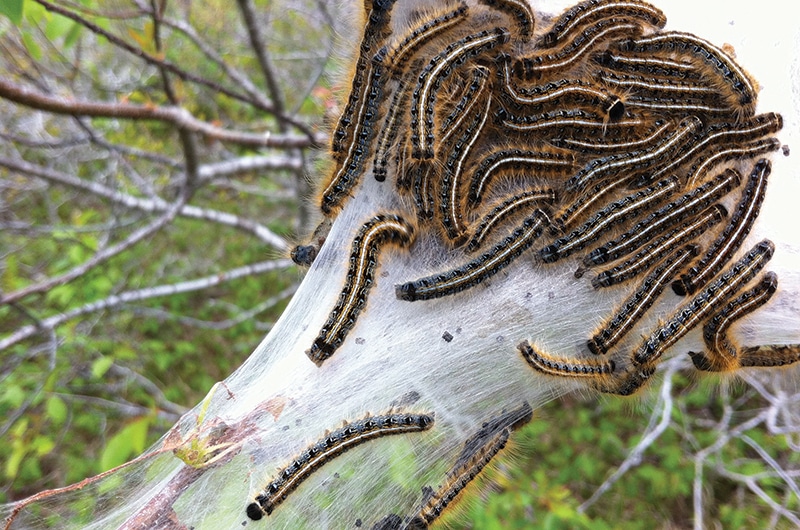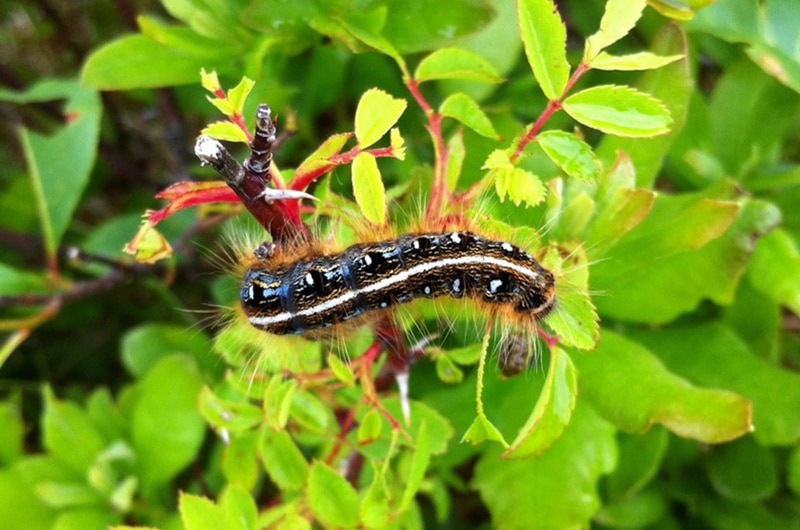by Dr. Sarah T. Bois, Director of Research & Education for the Linda Loring Nature Foundation

Not just for the hobby entomologists and naturalists, these communal caterpillars are noticed by everyone as they cover the native cherry and beach plums trees and shrubs around the island. While they actually hatch from their egg masses in early May, they are most visible later in the season (early June) when their tents have reached a size that can easily be seen while driving 30 mph down Madaket Rd.
While not everyone enjoys the presence of these insects, there are many wonderful things about the Eastern Tent Caterpillar that are often overlooked when homeowners are researching ways to obliterate them from their shrubbery. Below are just a few of my favorite things about Eastern Tent Caterpillars.
They’re amazing engineers. These caterpillars are such great tent builders it is part of their name! The tents are built by a group with individuals working together. Caterpillars that have hatched from different egg masses, but are in close proximity come together on one part of a tree (on Nantucket generally a Black Cherry or Beach Plum). Every day these little silk-spinning critters add layer after layer to their tent. This tent withstands Nantucket winds, rain, and sometimes a late spring sleet or snow. How do you think your tent would hold up to a Nantucket spring?
They’re communal living specialists. While they might not be little hippies, the Eastern Tent Caterpillar are kings (or queens) of commune living. They may hatch from different egg masses and not even be related, but Eastern Tent Caterpillar will shack up with the closest group of other Eastern Tent Caterpillars. Even before they build their tent together, the tiny, black hatchlings congregate on a sunny side of a branch for warmth absorbing the sun’s rays. Like all communes, however, the tent meets its end when everyone grows up. Towards the end of June, the Eastern Tent Caterpillar drop from the trees to pupate on the ground before becoming adult moths. What’s left of the tent is full of frass (aka caterpillar poop). It will soon whither in the summer sun. A true engineering marvel; tough and strong when needed yet biodegradable when no longer “in fashion.” We could learn a thing or two from our Eastern Tent Caterpillar friends.

They’re food for birds. An old wives tale persists that Eastern Tent Caterpillar are only edible to Cuckoos and poisonous to other birds. While not as palatable as other species, research from the University of Michigan shows that Eastern Tent Caterpillar are eaten by over 60 species of birds, many of which call Nantucket home (including orioles, jays, chickadees and nuthatches). When the Eastern Tent Caterpillar’s are having a boom year (generally three years out of every ten), there is a veritable buffet available for many bird species. It’s been noted by some local bird enthusiasts that their feeding stations are less active during the height of Eastern Tent Caterpillar activity. It is important to note, however that, while not poisonous, the guard hairs found on the Eastern Tent Caterpillar are irritants to the stomach lining of many animals including horses.
They’re climate indicators. Eastern Tent Caterpillar are extremely sensitive to temperature which serves them well as a species that feeds on fresh, spring leaves. They can take advantage of a warm spring and hatch early. I have successfully hatched them out up to a month early in captivity. They are used in many research projects, including at Nantucket’s Linda Loring Nature Foundation, to investigate the response to various aspects of global climate change including earlier springs, increased frost events, and potential ecological mismatches. While we’re still in the early stages for this kind of research on Nantucket, preliminary results show that our Eastern Tent Caterpillar track closely with minimum spring temperatures.
Natives Rule! While sometimes confused with the non-native invasive Gypsy Moth, the Eastern Tent Caterpillar is a native species to Nantucket and the northeast. As such, it has evolved with a series of checks and balances to live in this ecosystem. While they may do some damage to their host trees, Eastern Tent Caterpillar rarely kill a tree or shrub unless it is already weakened or otherwise unhealthy.
So, even though there all kinds of things we can learn from Eastern Tent Caterpillars, what do you do if you still want to get rid of them in your yard? First of all you could prevent them hatching by removing the egg masses during the fall or winter. That would involve scraping them off with a knife. If you ID where the eggs are, you could remove just the end of those branches. Alternatively, you could put sticky tape on the branch to stick the hatchlings so they can’t eat or travel the tree. Whatever you decide to do, please do not spray an insecticide. There are no insecticides that are specific to Eastern Tent Caterpillar. Thus, if you spray for Eastern Tent Caterpillar, you will likely kill any bees, butterflies, or other pollinators in your yard. This will also limit birds to your property and cause a trickle down of harm and biodiversity loss.


